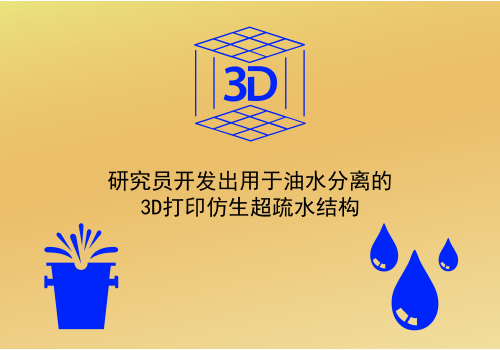Researcher Develops 3D Printing Bionic Super Hydrophobic Structure for Oil-water Separation
Classification:
Company news
Author:
2018/03/29 08:45
[China's Smart Manufacturing Network Technology Frontier] There is hardly any more environmentally damaging pollution than oil spills, and the consequences will continue for years after the initial disaster. Despite the best efforts of mankind, leaked oil is not easy to clear, but nature may have a solution, just as it does for many things. Researchers at the University of Southern California are working on a specific blade structure to make a mass-produced material that is easier to remove than the materials currently used.

Researcher Develops 3D Printing Bionic Super Hydrophobic Structure for Oil-water Separation
Salvinia molesta is a floating fern native to South America. Its leaves are very hydrophobic and retain an air bag when submerged in water thanks to the tiny waterproof hair.
"I think the reason why plants are super-hydrophobic is that they live on the water and they need air to survive," said Yang Yang, a postdoctoral researcher. "If it is not the long-term evolution of this plant, the plant may be submerged in water and die."
At the microscopic level, the leaves are arranged in a manner similar to an egg beater or tweezers. Researchers used immersive surface area poly 3D printing (ISA 3D printing) methods to recreate this whisk's microstructure using plastics and carbon nanotubes, called the Salvinia effect. The result is a highly hydrophobic and oleophilic or oil-absorbing material. This combination allows effective separation of oil and water.
Associate Professor Yong Chen said: “We tried to create a functional surface texture that separates oil from water. Based on this, we modified the surface of the material by using 3D printing methods, which helped us to obtain some interesting surface characteristics.”
The research team hopes that eventually they will use 3D printing as a prototype and they can be manufactured on a large enough scale to separate oil and water from the ocean. Currently, this method requires a lot of electric field or mechanically applied pressure energy.
The Salvinia effect can also be used for other applications, including medical applications. It can be used for droplet operations where the adhesion of the liquid to the robot arm can be adjusted accordingly and results in a lossless transfer of the trace amount of liquid. The technology can be used in many different applications, including droplet-based microreactors, nanoparticle synthesis, tissue engineering, drug discovery, and drug delivery monitoring.
One possible application of high-performance droplet manipulation is to perform more effective blood analysis on the patient. Robotic grippers can move to different sites and dispense droplets of blood, and then mix them evenly with different chemicals for testing. These tests can also be designed to control the ratio of chemicals to droplets, and can preserve raw materials and chemical reagents.
"You can use a robot arm to imitate the ‘Salvinia effect,’” says Xiangjia Li, a doctoral student. "Whatever method you use to move your arm, the grip is so great that the droplets will remain attached."
It is reported that this research has been published in a paper entitled “3D printing bionic superhydrophobic structure for droplet operations and oil/water separation”. The authors include Yang Yang, Xiangjia Li, Xuan Zheng, Zeyu Chen, Qifa Zhu, and Yong. Chen.
Article link: China Intelligent Manufacturing Network http://www.gkzhan.com/news/detail/108701.html
Key words:
[State Council Policy] How the reform can make innovation run out of "acceleration"——The Party Secretary of the Ministry of Science and Technology Wang Zhigang authoritatively interprets the construction of a scientific and technological power
2018-03-29
What process is used for steel wastewater treatment? Zero emission model is the focus
2018-03-29
Researcher Develops 3D Printing Bionic Super Hydrophobic Structure for Oil-water Separation
2018-03-29
Development of smart manufacturing solutions
2018-03-29
Related news


